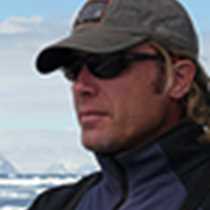Detaille Island, Crystal Sound
After making steady progress north through the night along the western reaches of Adelaide Island the National Geographic Endeavour found herself in the southern reaches of Crystal Sound just north of Detaille Island. The winds were moderate and the sky overcast. Detaille is a small island but she harbors one of the most historically significant outposts in the Antarctic Peninsula region, a British Antarctic Survey (BAS) base erected in the 1950s, and built for scientific investigation and cartographic mapping.
We Zodiac cruised ashore through some wind-driven chop, negotiating a contingent of sizeable and threatening icebergs surrounding Detaille Island's low points where our landing was to take place, and stepped ashore on to some late-season hard snow. From here it was a short hike to hut. The island boasts little walking terrain, and the hut, though roomy for a contingent of yesteryear's researches and explorers, could hardly handle a full compliment of our vessel's guests. The overflow was taken on a Zodiac cruise to view icebergs and local wildlife.
The old relic of a base held a treasure trove of historic items to peruse. The base was itself a time capsule. Canned foods, climbing and ski gear, old periodicals and books, cookware, and most interestingly notes and documents from former research and exploration - to name a few, kept from the ravages of time and decay by the extreme cold, gave us a lens through which to view a piece of the Crystal Desert's human history. Outside crabeater seals were generously sprinkled among some of the ice floes, while numerous Weddell seals lounged contentedly on the rocky shores. Some of the icebergs were impressive and as varied as snowflakes in shape and form. Virtually all possessed those most remarkable of icy features - bolts of electric blue in their cracks and corners, the result of evolution from snow to ice and finally to icebergs calved from their parent glaciers after a lifetime as subjects to the forces of time, pressure, and gravity.
After weighing anchor the National Geographic Endeavour made way on a southerly course into the northern reaches of Hanusse Bay. Our mission here was to cruise along the edge of the pack in search of wildlife. A lightening of the sky, caused by the reflection of light from the sea ice, let us know the pack was just ahead. Unlike our encounter with the pack in Hanusse Bay, the pack ice here was unconsolidated. Broken fragments of brash ice, large and small pancakes, slushy snow and ice on the sea's surface, provided a matrix that loosely held a generous array of differently-sized icebergs. The sky was dense with moisture; a light snow began to fall. Snow petrels wheeled around our vessel in semi-profusion. One large pancake even held a reposing contingent of some 20+ of these angles of the Antarctic. A few skuas, hardy as burl and tough as prizefighters sat unconcerned on the ice floes, and broke the stark whiteness of the scene with their dark, barrel-chested bodies. Before long the ship's clock let us know that the National Geographic Endeavour was due to head north once again through the snow and into a shroud of cold, dark southern sky.




